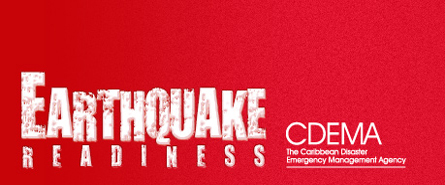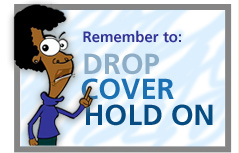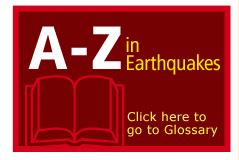|
Earthquakes happen with no warning; therefore, life-protecting actions must be taken at the first indication of ground shaking. Even in the most severe earthquakes, buildings rarely collapse completely. Injury and even death are most often caused by the shattering and falling of non-structural elements, such as window glass, ceiling plaster, lighting fixtures, chimneys, roof tiles, and signs. There will be no time to think what to do; therefore, of all earthquake-preparedness measures, EARTHQUAKE DRILLS ARE THE MOST IMPORTANT. REACTION MUST BE AUTOMATIC AND CORRECT ACTION!
Regular earthquake reaction and evacuation drills should occur separately from, but with the same frequency, as fire drills. Drills should regularly simulate emergencies such as jammed doors, and blocked hallways and stairways. Simulation exercises should occur outdoors as well as inside the school. DO NOT RUN! Identify a safe gathering place outside. This should be away from the building(s), trees, playground structures, fences, utility wires or anything else that has fallen, been damaged or may fall on you. Make this your designated gathering place in case of earthquake or other disaster. Ensure that all children and staff know where to go if they need to leave the building in an emergency.
Plan several routes for getting out of the building after an earthquake and practice evacuation drills regularly. All children including handicapped students should participate. Know the evacuation routes from your building and document these in your schools disaster plan. For information on evacuation routes from your building contact your NDO for referral to the appropriate authority.
Copies of the standard drill procedures should be given to each teacher to implement in the classroom.
Safety Chant
"If inside, Drop, Cover and Hold.
That's where you'll be safe.
If outside, stay outside,
and find an open space."
Earthquake Drill Preparation
Earthquake and tsunamis drills should be preceded by classroom discussions. These should be about the need for and purpose of drills. The contents of this website may be used to explain what to expect, what to do, and why. Teachers should dispel myths, such as "The earth will open up and swallow you." Tell the children that during an earthquake, the earth might move beneath their feet like waves. Explain that earthquakes may be noisy, with loud banging, crashing or rumbling sounds and ringing alarm bells. The noises of building movement, windows breaking, and objects falling that accompany an earthquake can cause emotional stress and panic. Students should be prepared for this by classroom discussion.
Spend time explaining the Drop, Cover and Hold drill and demonstrate what you want them to do. Get their attention and give clear, distinct commands. Speak in a calm voice. At the command of "earthquake", you and the children should immediately Drop, Cover and Hold.
Because earthquakes may come at any time, practice Drop, Cover and Hold drills outside, in your play areas and in various parts of your facility.
Students can carry out projects that are both useful and educational; for example:
- Prepare an earthquake safety kit to be kept near the exit door, for which students can suggest contents, such as:
- Copy of class roll book
- Identification tags for each child that indicate name, age, address, phone, parents' names, work address and phone, any medical problems
- First aid supplies
- Flashlight and spare batteries
- Felt pen (for I.D. marking)
- Games
- Plastic garbage bags for emergency protection.
- Make posters describing what to do in the event of an earthquake
- Identify hazards in the classroom, school, school grounds, neighbourhood, and home
- Identify safe places in each room
back to top
During an Earthquake
Indoors Or Outdoors, Take Action At The First Indication Of An Earthquake.
Indoors - In Class:
The following are recommended drill procedures for a teacher and class of students:
- "Drop, Cover and Hold on"
- DROP to the ground
- TAKE COVER under a sturdy table or other piece of furniture. Kneel and bend your head close to your knees.
- HOLD ON to the table leg or desk (a few inches above the ground to avoid pinching fingers). Cover your eyes with your other hand. If your "shelter" moves, move with it.
- Do not get between a piece of furniture and a solid wall, shelter on the side away from the wall or under it.
- FACE AWAY from windows
- If you don't have a shelter to hang on to, drop and cover with your hands linked on the back of your neck, and cover the side of your head with your arms to protect your neck, head and face.
- Remain in place until the shaking stops. COUNT ALOUD to 60 -- earthquakes rarely last longer than 60 seconds and counting is calming.
In other areas within the school building:
At the first sign of an earthquake, occupants should:
- Move away from windows, shelves and heavy objects that may fall
- Take cover under a table or desk or in a corner
- In halls, stairways and other areas where no cover is available, move to an interior wall; kneel with back to wall; place head close to knees; clasp hands behind neck; and cover side of head with arms
- In the library, move away from where books and bookshelves may fall and take cover
- Stay inside -- usually the most dangerous place is just outside where building debris may fall; exit only after the shaking has stopped
- In science laboratories, extinguish all burners, if possible, before taking cover; stay away from hazardous chemicals that may spill
- In other areas, such as gymnasiums, auditoriums, music rooms, and industrial education shops, the district or school committee should prepare appropriate guidelines based on the above.
Outdoors:
Students and teachers should move to an open space away from buildings, fences, trees, tall playground equipment, lights and overhead power lines. Kneel or sit on the ground and cover your head and face with your hands. Once in the open, stay there until the shaking stops.
In a Vehicle/School Bus:
The driver should stop the bus away from power lines, bridges, buildings, and overpasses. Occupants should Drop down between the seats (which will act as a shield), Cover, and Hold on. Be aware that heavy objects may fall from overhead racks, Count to 60.
The teacher should:
- Issue the "earthquake" order
- Also drop, cover and hold until the shaking stops
- Review evacuation procedures.
If the teacher is injured, two student monitors should have designated authority to give instructions.
Don't:
- Don't try to take cover in a doorway during an earthquake. The door may slam on you.
- Do not run outside during the shaking or use the stairways or elevators. Many people are killed just outside of buildings by falling bricks and other debris.
- Do not try to use your telephone for the first 90 minutes after an earthquake, except for serious medical or fire emergency, or if victims are trapped. You could tie up the lines needed for emergency response.
back to top
|













